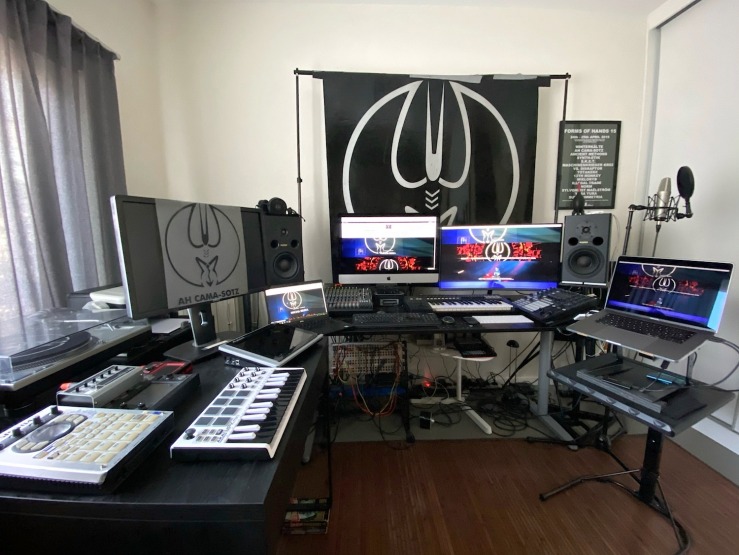
Terra Inhibita VI
Production & Mastering Studio
https://www.facebook.com/illlektrik.toolz/

ABOUT MASTERING
In fact “mastering” is pre-mastering, adjusting the sound for the best possible quality and balance.
Making the glass master is the final mastering, which should not change the sound at all. Through the development of sophisticated digital editors and automation, fine-tuning of each song can be done which was difficult or impossible just a few years ago. Each song’s level, or relative volume, is adjusted so that they match from song to song.
The EQ, or spectral balance, is also adjusted, both overall and for each cut. Many times each song has a dynamic range that may need to be enhanced by making it larger or smaller (more dynamic if it was overcompressed previously, less dynamic if suited for the music).
ABOUT THE MUSIC STYLES
Dealing with subculture & underground, we are well aware what’s happening in our parallel world and sub-society.
We are close to industrial, dark-ambient, rhythm ‘n’ noiz, electronic, experimental, drum ‘n’ bass, breakbeat, techno, house, lounge, metal, noise, dub, …
just to name a few! Well, the most important thing: we know how to process these styles of music.
MASTERING
This is the final step in the recording process. it’s the little things that make a big difference in this process.We carefully listen to the program material, and decide on what the best process is for broadcast.
We add equalisation, compression, correct phase problems, smooth out bad fades and adjust volume of each track. The process never leaves the digital domain.
Stem mastering: more about this topic on our mastering section page!
WORKFLOW
¬ disable any effects on the stereo output, no compressors, EQ, limiters or whatever on the stereo mix. we only need your finished stereo mix.
¬ provide us a stereo mix of the finished song using the bounce function in Logic / Pro tools or export function in Cubase / Nuendo.The preferred peak is around –6 / -8dBFS.
¬ burn a copy of the songs as a data session (.wav or .aiff file 16 or the prefered 24bit).
¬ provide us a tracklist with songtitles, tracktimes, …
¬ having specific preferences for the processed material, provide us a separate sheet with your requirements.
¬ we deliver DDP and/or 1 red-book reference CD-Rs ready for duplication.
full length CD / LP mastering: 220,00 €
mastering 4 tracks: 120,00 €
mastering 1 track: 35,00 €
stem mastering: 220,00 € – 8 stems
remixing a track: 125,00 €
info@ahcama-sotz.com
|
BEFORE MASTERING YOUR TRACK !! KEEP THIS IN MIND !!
LEVELS: PLEASE, PLEASE, PLEASE LEAVE SOME HEADROOM IN YOUR MIXES!
This is perhaps the number one problem we encounter in today’s world of digital limiters, maximizer plug-ins, etc.
If the delivered mixes are already heavily limited and running right up to 0dBFS, there is MUCH less that can be accomplished in the mastering process to correct any problems that may exist. If it is necessary to create “take home” or “pre-mastered” mixes that are super loud through limiting, clipping, etc., please create a finished mix with at least -6 dB of peak headroom for delivery to mastering (for accurate metering, check https://www.sonalksis.com/freeg.htm), and then to do any further processing to that mix for take home/reference mixes. These versions can be used as a reference for mastering too and can usually be improved upon, but only if there is some room to work! Listen carefully to your mixes for clipping and distortion, these problems usually become much more apparent during mastering and can be difficult or impossible to fix in a transparent fashion.
HEADS AND TAILS: The space before the beginning and after the end of each track often contains more than one would think. There is no penalty involved in waiting until mastering to chop off or clean up these spots and it is not uncommon to find that the end of a delicate fade out got cut short during a long mix day. We recommend leaving 2 to 3 seconds of silence, buzz, or whatever before and after each mix.
COMPRESSION on elements such as drums or vocals that seem fairly transparent during mixing can often become much more up front at mastering. Small amounts of equalization can reveal detail that often make compression artifacts much more audible than was intended. Unless a pumping type of compression sound is desired as an effect, less is always more. Longer release times help to minimize this effect as well. (Please do not take this to mean you should not use compression within your mixes, it is simply meant to point out that you may end up hearing the effect of significant amounts of compression more in a finished master than was apparent in your source mix. If you like the way compression sounds in a mix, by all means, go with it!)
VOCAL SIBILANCE is a common byproduct of the kind of close mic-ing and eq techniques that predominate today. This is one of the issues commonly dealt with during mastering, but even with powerful mastering tools, attempts to reduce vocal sibilance will often affect other elements in a mix. Things such as acoustic guitar shimmer, snare drum and bass drum top end (and other elements that are generally in the center of the stereo field) can be reduced at the same time as the sibilance. SO, being aware of excessive sibilance and trying to manage it while mixing can make the mastering process easier and involve fewer trade-offs with other elements in the mix during mastering.
CLIPPING busses and other amplifier stages while mixing can be a satisfying way to get levels up and add intensity to a mix, but can sometimes backfire in mastering. As a mix gets cleared up and adjusted, sometimes the “crunchies” that result from bus clipping and the like become heavily featured. There aren’t a lot of good options to undo this sort of problem across a whole mix, so the best option is usually to try and avoid this situation. It isn’t difficult to emulate this sort of sound at mastering without adding unmusical distortion artifacts.
DELIVERY FORMATS:
DIGITAL FORMATS: Our preferred format is 24-bit stereo WAV (or Broadcast WAV). But we can accept stereo or dual-mono data files in the following formats: AIFF, SDII, CAF, BWF, and WAV. The sampling rate should be the native sampling rate of your recording and mixing project. Do not sample rate convert. Our recommendation is for you to record and mix at either 44.1kHz, or 96kHz. Forget about 48kHz and 88.2kHz. 16-bit wordlengths are acceptable, but 24-bit is a much, much better idea (If you are coming in with a CD that plays in a CD player, this is a 16-bit format). Data discs are much better than Audio CD-Rs, however, when using Data CDs or DVDs, we strongly recommend making 2 copies. We have had a number of sessions aborted due to a corrupted disc. BEST is to send your production via WeTransfer!
STEM MASTERING:
Stem mastering is a different method of mastering audio which traditionally uses the stereo 2 track mixdown files. There is some confusion surrounding stem mastering as it appears to be akin to mixing, however this is not the case. Stem mastering utilizes groups of instruments such as bass, guitars, vocals, drums, synths, brass section etc. The mastering engineer requires these groups of instrumentation to successfully perform stem mastering. Stem mastering allows the engineer extra flexibility when adjustments are being made to the overall sound of the music. the goal is still based on ensuring your music translates as good as is possible to as many sound reproduction systems as possible.
Stem mastering does not rely heavily on automation of levels, adding effects and vocal tuning, this is the remit of the mix down session. The basis of stem mastering is to allow the mastering engineer extra flexibility if needed to improve the mastering end results. Little volume tweaks here and there, characterful processing of certain groups of instruments, warming them up, adding width, punch or specific equalization. Stem mastering can be requested if a client does not have 100pct confidence in their mix down, such issues can be communicated to the mastering engineer and he or she will be able to take these points into consideration when working with the music.
Stereo processing will also feature during a stem mastering session in much the same way as 2 track mastering. Stem mastering is usually a little more costly that stereo mastering as the project will take longer to set up and the extra consideration of more sources also takes extra time. The end results can in many instances be better than 2 track mastering alone.
The distinction is really that mixing is working with multi track recordings, eqing, effecting, balancing, compressing, automating and blending all the sounds together as they were recorded. Stem mastering rarely uses more than 8 stereo stems (instrument groups)per master, whereas a mix down can be many individual tracks and performance takes.
When you prepare your tracks for stem mastering ensure you export as 24 bit .aiff or .wav files. Do not send data compressed file formats such as MP3. Also make sure that you export the files from precisely the same place in the timeline of your workstation so they will synchronize in your mastering engineers DAW. the stems should re-combine to sound very much like your original mixdown. It can sometimes be useful to send the original stereo mix as well as the stems. |
selection of masterings, labels & bands
EE Tapes – Hands productions – Ant-zen – Spectre – Pflichtkauf – Bats & Cats – Brume Records – De Luidspreker – Sturm – Sealt – Dark Ambient Radio – Ah Cama-Sotz – Fischfleischplatten
ah cama-sotz – gatto nero – this morn’ omina – kraken – skincage – mimetic – stupor – antigen shift – hybryds – salt – asche – the (law-rah) collectve – def- project arctic – ahnst anders – aktivate sin – allerseelen – camanecroszcope – config.sys – converter – dazzling malicious – edgy – forms of hands compilations – frames a second – genetic selection – greyhound – heimstatt yipotash – hypnoskull – hysteresis – iszoloscope – kraken – kom-intern – l’ombre – loss – lyth – maschinenfest compilations – merzbow – mono no aware – needle sharing – necrotic – noisex – norm – OKK-ULTh – orphx – p.a.l – pow[d]er pussy – roger rotor – proyecto mirage – punch inc. – saemskin – saverio evangelista – scrap.edx – shorai – s.k.e.t. – skincage – starfish pool – stupor – synapscape – synth-etik – typhoid – tzolk’in – the [law-rah] collective – to mega thereon – thinner – von magnet – wai pi way – xabec – 5F_55 – Hash Bamboo Shuffle – Collapsar – Maeror Tri – Pseudo Code – Dieter Muh – Brume – BeNe GeSSeRiT – M.A.L. – Human flesh – I SCREAM – sylvgheist maëlström – sylker – Irklis – KiEw




Leave a comment